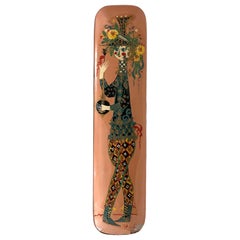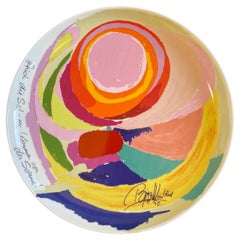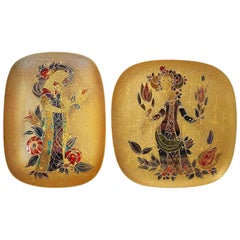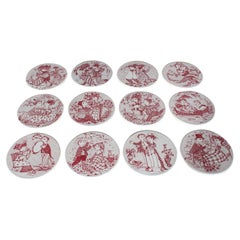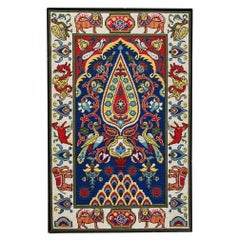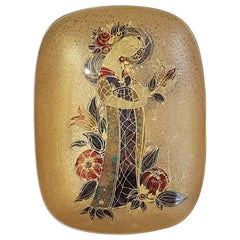Mid-20th Century Decorative Art
3
to
3
3
3
3
2
10
3
7
1
5
Height
to
Width
to
2
2
1
3
2
1
1
45
25
24
24
17
Period: Mid-20th Century
Creator: Bjørn Wiinblad
Vintage Danish Bjørn Wiinblad Wall Hanging for Illums Bolighus, 1961
Located in Frederiksberg C, DK
Vintage Danish Bjørn Wiinblad Wall Hanging for Illums Bolighus, 1961
Own a piece of Danish design history with this rare wall hanging by renowned artist Bjørn Wiinblad, created for ...
Category
Danish Vintage Mid-20th Century Decorative Art
Materials
Plaster
Artist Plate No. 7 by Bjørn Wiinblad for Rosenthal, Mid-Century, 1970s Germany
Located in Andernach, DE
''Auch die Schatten kommen von der Sonne'' (''Also the shadows are made by the sun'') –
is the No. 7 of the ''Artists-Plates'' from the Studio-Line by Rosenthal.
With a limited edi...
Category
German Mid-Century Modern Mid-20th Century Decorative Art
Materials
Porcelain
Pair of Rare Hand Painted Gilded Platter by Bjørn Wiinblad, 1960s
Located in Rijssen, NL
A magnificent hand painted Bjørn Wiinblad Rosenthal platter made for the studio line ceramics.
Signed Bjorn Wiinblad. Decorated in 24-karat gold with an iridescent pattern. A fantastic collector’s item.
Please note: This plates are heavy, weighing about pounds. It will be very well packed to ensure safe arrival.
Including a rectangular platter...
Category
German Mid-Century Modern Mid-20th Century Decorative Art
Materials
Porcelain
Related Items
12 Month Wall Plaques by Bjorn Wiinblad
Located in Esbjerg, DK
A complete set of 12 beautiful red and white wall plates, designed by Bjorn Wiinblad for Nymolle Denmark, 1970s.
Each of these plaques represents ...
Category
Danish Scandinavian Modern Vintage Mid-20th Century Decorative Art
Materials
Ceramic
Large Vintage Needlepoint Wall Hanging
Located in Jacksonville, FL
Large framed needlepoint wall hanging features a colorful mix of horses, birds, lions, and elephants. Wood backing stamped "Bohemia". Good con...
Category
Bohemian Vintage Mid-20th Century Decorative Art
Materials
Canvas, Wood
12 Decorative Month Wall Plaques by Bjorn Wiinblad for Nymolle, Denmark, 1970s
Located in Esbjerg, DK
A complete set of 12 beautiful black and white wall plates, designed by Bjorn Wiinblad for Nymolle, Denmark, 1970s. Each of these plaques st...
Category
Danish Scandinavian Modern Vintage Mid-20th Century Decorative Art
Materials
Ceramic
Set of 3 Bjørn Wiinblad for Rosenthal, Christmas Glass Plates 1976, 1977 & 1980
Located in Andernach, DE
Bjorn Wiinblad, Danish artist, has created this beautiful series for German art glass & porcelain makers Rosenthal for their Studio-Line art edition.
The Christmas decoration has bee...
Category
German Mid-Century Modern Mid-20th Century Decorative Art
Materials
Crystal
H 0.6 in W 11.42 in D 11.42 in
Plaquettes by Danish Designer Bjorn Wiinblad for Norwegian Nymolle Pottery
Located in Waddinxveen, ZH
This a complete set of 12, one for each month of the year. All are done in black and white and are in a very good condition. They have a small hole to thread a ribbon or a piece of l...
Category
Norwegian Scandinavian Modern Mid-20th Century Decorative Art
Materials
Ceramic
1970s VASARELY "Live and let live love and let love" Rosenthal Framed Plate
Located in North Hollywood, CA
1970s VICTOR VASARELY "Live and let live love and let love".
Rosenthal collectible framed German plate.
Victor Vasarely Rosenthal Studio Line Limited Edition Porcelain Plate.
By Vasarely born 1936.
"Leben und Leben lassen, Lieben und Lieben lassen"
"Live and let live - love and let love".
Limited edition, signed and numbered.
Plate is in good condition, size is 12".
Frame is not in good condition, white became yellowish shows wear.
Victor Vasarely, born as Győző Vásárhelyi on April 9, 1906, in Pécs, Hungary, was a Hungarian-French artist widely regarded as the "father of Op Art" (Optical Art). He is known for his pioneering work in geometric abstraction and the use of optical illusions to create visually captivating and dynamic artworks.
Vasarely's early career involved studying medicine in Budapest, but he later decided to pursue his passion for art and enrolled in the Műhely (Workshop) academy in Hungary. He initially experimented with various styles, including Impressionism and Post-Impressionism, but his interest in geometric abstraction grew stronger over time.
In the 1930s, Vasarely moved to Paris, where he continued to explore geometric patterns, lines, and shapes in his art. He believed that art should not merely imitate nature but should create its own language of forms and colors to engage the viewer's perception actively. This philosophy led to the development of Op Art, a movement that emerged in the 1960s and focused on creating optical illusions and visual effects through precise geometric patterns and colors.
Vasarely's artworks often featured meticulously arranged geometric shapes, giving the impression of movement and three-dimensionality. He employed various optical tricks, such as the juxtaposition of contrasting colors and the use of repetition, to create an illusion of depth and visual dynamism. His artworks can evoke a sense of visual vibration and often challenge the viewer's perception.
Throughout his career, Vasarely's influence extended beyond the art world. He believed in the democratization of art and wanted to make art accessible to a wider audience. He embraced mass production techniques, creating what he called "multiple originals" or "serigraphs" (a form of screen printing). These serigraphs allowed him to produce multiple copies of his artworks at affordable prices, making them more accessible to art enthusiasts.
Vasarely's artistic legacy continues to be celebrated around the world. His work has been exhibited in numerous galleries and museums, and he remains an influential figure in the fields of Op Art and abstract geometric art. He passed away on March 15, 1997, in Paris, leaving behind a vast body of work that continues to captivate audiences and inspire artists to this day.
About Rosenthal:
German porcelain manufactory Rosenthal was originally founded as a ceramics-painting studio by Philipp Rosenthal Sr. (1855-1937) in 1879 at Schloss Erkersreuth in Bavaria, near the Czech border. Its first highly popular product was an ashtray inscribed with the words “Resting place for lit cigars.” In 1890, the company moved to the neighboring hamlet of Selb and, a year later, began to manufacture its own porcelain, since white porcelain was, at that time, in short supply. Rosenthal’s first complete table service was called Empire; it was exhibited along with other lines at Paris’s Exposition Universelle in 1900.
With the dawn of the 20th century, Rosenthal began producing porcelain tableware and services formed and decorated in the latest styles, like the Jugendstil Botticelli (1903), the Art Nouveau Darmstadt (1905), and the all-white Maria (1916) lines. Successes with this au courant approach led the company to launch an art pottery division in 1910, dedicated to luxury tableware, vases, and other decorative objects. By the 1930s, figurines were another important Rosenthal product, most notably the Disney-licensed Mickey Mouse pieces introduced in 1931.
In 1934, Philipp Rosenthal was forced to leave his company and country when his Jewish ancestry came under persecution by the Nazi regime. Despite the loss of its founder, the Rosenthal company remained the premier supplier of high-quality porcelain tableware to the Third Reich. After the war, in 1950, Philip Rosenthal Jr. (1916-2001) joined his father's company as an advertising manager. By 1958, he had become its CEO, continuing his father’s vision to produce high-quality porcelain in line with progressive tastes. Through the rest of the 20th century, Rosenthal was the most commercially successful porcelain producer in Germany.
In the postwar era, Rosenthal’s most famous tableware lines have included 2000 by Raymond Loewy and Richard Latham (1954), Magic Flute by Bjørn Wiinblad (1959), Suomi by Timo Sarpaneva (1976), and Moon by Jasper Morrison (1997). The company has enjoyed many popular and critically acclaimed collaborations with designers and brands, like Salvador Dalì, Tapio Wirkkala, Walter Gropius, Andy Warhol, Ron Arad, Enzo Mari, Konstantin Grcic, and Versace.
Rosenthal's product lines have encompassed more than ceramics over the years. In 1972, the company began producing furniture, under the subsidiary Rosenthal Einrichtung, in Espelkamp, Germany. Standouts from this arm of Rosenthal include Gunter Ferdinand Ris and Herbert Selldorf’s futuristic Sunball Lounge Chair (1969), Verner Panton’s Relaxer Rocking Chair (1974), Burchard Vogtherr's Vario Pillo...
Category
German Post-Modern Mid-20th Century Decorative Art
Materials
Porcelain
H 15.5 in W 15.5 in D 2 in
Rosenthal Studio Line Porcelain Plate by Björn Wiinblad 'Limited Edition'
Located in Waddinxveen, ZH
Stunning wall plaque by Bjorn
Wiinblad for Rosenthal. The plaque was produced in 1975 in an edition of 5000, and this one is number 1328.
The text on the plate is German ‘auch die...
Category
German Mid-Century Modern Vintage Mid-20th Century Decorative Art
Materials
Porcelain
Vintage Printing Block Collage Wall Hanging
Located in Kilmarnock, VA
Wonderful collaged Printing Block wall hanging made from old printing blocks and an old drawer. Made in the 1960s it has the feeling of the artist Louise Nevelson but at a fraction...
Category
American Mid-Century Modern Vintage Mid-20th Century Decorative Art
Materials
Wood
12 Month Wall Plaques by Bjorn Wiinblad
Located in Esbjerg, DK
A complete set of 12 beautiful black and gold wall plates, designed by Bjorn Wiinblad for Nymolle Denmark, 1970s.
Each of these plaques represents ...
Category
Danish Scandinavian Modern Vintage Mid-20th Century Decorative Art
Materials
Ceramic
Vintage Bjorn Wiindblad Decorative Plate 1001 Nights Lute Player Plate
Located in San Diego, CA
Beautiful collectible plate from the famous Danish artist Bjorn Wiinblad (Bjørn Wiinblad). The plate was designed for Rosenthal, Germany and is deco...
Category
German Mid-Century Modern Vintage Mid-20th Century Decorative Art
Materials
Gold Leaf
7 Hand Painted & Signed Bjørn Wiinblad Porcelain Plates for Rosenthal, 1970s
Located in Andernach, DE
Bjorn Wiinblad, Danish artist, has created this beautiful series for German art glass & porcelain makers Rosenthal for their Studio-Line art edition.
Plates from 1975 with the Annunc...
Category
German Mid-Century Modern Mid-20th Century Decorative Art
Materials
Porcelain
Vintage 12 Masks Chinese Wall Hanging
Located in Delray Beach, FL
Stunning colorful lacquer hand painted vintage 12 masks Chinese wall hanging. This is from the 1960s and is signed with a description attached to the back pictured in the photos.
Gr...
Category
Chinese Mid-20th Century Decorative Art
Materials
Ceramic, Wood
Previously Available Items
Rare Rosenthal Studio Hand Painted Gilded Platter by Bjorn Wiinblad, 1960s
Located in Rijssen, NL
A magnificent hand painted Bjorn Wiinblad Rosenthal vase made for the Studio Line ceramics.
Signed Bjorn Wiinblad. Decorated in 24-karat gold with an iridescent pattern. A fantastic...
Category
German Mid-Century Modern Mid-20th Century Decorative Art
Materials
Gold
Free Shipping
H 23 in W 23 in D 32 in
Rare Rosenthal Studio Hand Painted Gilded Platter by Bjorn Wiinblad, 1960s
Located in Rijssen, NL
A magnificent hand painted Bjorn Wiinblad Rosenthal vase made for the Studio Line ceramics.
Signed Bjorn Wiinblad. Decorated in 24-karat gold with an iridescent pattern. A fantastic...
Category
German Mid-Century Modern Mid-20th Century Decorative Art
Materials
Gold
Free Shipping
H 23 in W 23 in D 32 in
12 Decorative Month Wall Plaques by Bjorn Wiinblad for Nymolle, Denmark, 1970s
Located in Vienna, AT
A complete set of 12 beautiful black and white wall plates, designed by Bjorn Wiinblad for Nymolle Denmark, 1970s. Each of these plaques sta...
Category
Danish Mid-Century Modern Mid-20th Century Decorative Art
Materials
Ceramic
Recently Viewed
View AllMore Ways To Browse
Fritz Frohse On Sale
E Renmark
Emmett Kelly
Hummel Plates
Lighting Agostino
Henri Samouilov
Thomas DeDecker On Sale
Original Enameled London Underground Subway Sign
Patria Watch
Schumacher Madame
Une Femme Douce
Tile Mural Peacock
Mac Duggal
Bedlington Terrier
Andre Ducuing
Guido Maggiori
Irina Lorin
Jaws 2 Movie Poster
